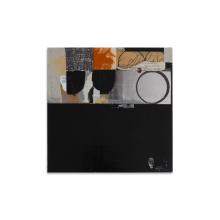Eat | Biang Biang Noodles

-
NOODLES
Step 1
Stir ½ tsp. Diamond Crystal or ¼ tsp. Morton kosher salt and ¾ cup plus 2 Tbsp. room-temperature water in a small bowl until salt is dissolved. Place 3¼ cups (406 g) all-purpose flour in a large bowl and drizzle salt water evenly over. Stir with a wooden spoon or chopsticks until shaggy clumps form. Knead firmly in bowl until a tight, mostly smooth dough forms, 8–10 minutes (there may be some dry bits but you should not have any large patches of dry flour). Cover with a damp kitchen towel and let sit 15 minutes.
Step 2
Turn dough out onto a surface and knead 1 minute (set a timer!). Cover and let rest 15 minutes. Repeat kneading and resting process two more times. By third kneading, dough should be noticeably softer and evenly smooth.
Step 3
Flatten dough into a 9x6" rectangle, then cut into 6 strips (about 100 g each). Roll each strip into a ¼"-thick rectangle (4"–6" long). Drizzle about 1 Tbsp. vegetable oil in a container that will hold all the strips when stacked on their sides. Place a dough strip into container and turn to coat on all sides evenly with a thin film of oil. Repeat with remaining strips, adding more oil as needed. Stack strips side by side (like books on a shelf) in container. Cover with plastic wrap and let sit at room temperature at least 1 hour.
Step 4
Working with 1 strip of dough at a time and keeping remaining dough covered with plastic wrap, flatten to 3"–4" wide and about 6" long with the heel of your hand. Grasp each end of strip between a thumb and forefinger. Hold parallel to surface and gently pull slowly and evenly until shoulder-width long (allow gravity and natural stretch of dough to do most of the initial work). Continue to slowly pull dough, maintaining even tension on both sides and slapping gently against the counter to prevent the dough from tearing, until 38"–44" long. Using your thumb nail, puncture strip in the center and rip to separate, stopping before reaching ends of strip (you should have what looks like a very large noodle ring). If tabs of dough at ends of strip are too thick, press to flatten; set aside (no need to cover).
Step 5
Working with 2 or 3 noodles at a time, cook in a large pot of boiling water (do not salt) until al dente, about 2 minutes. Using tongs, transfer to a sieve and drain any excess water.
Do ahead: Dough can be made 3 days ahead. Tightly wrap strips and chill. Bring to room temperature before stretching into noodles.
-
SAUCE AND ASSEMBLY
Step 6
Cook 8 Napa cabbage leaves, cut into 2" pieces, in reserved pot of boiling noodle water until wilted, about 45 seconds. Drain and transfer to a large bowl and add noodles.
Step 7
Heat 1 cup vegetable oil in a small saucepan over medium until very hot and starting to shimmer but not smoking, about 4 minutes.
Step 8
Meanwhile, add ½ cup soy sauce, ¼ cup black (Chinkiang) vinegar, and 1 Tbsp. sugar to bowl with cabbage and noodles and toss to combine. Pile 2 celery stalks, thinly sliced, 4 scallions, thinly sliced, 4 garlic cloves, finely grated, and ¼ cup gochugaru (coarse Korean red pepper powder) or Aleppo-style pepper on top of noodles.
Step 9
Carefully drizzle hot oil over noodles, concentrating on aromatics to cook them lightly. Toss with tongs to coat noodles evenly.
Step 10
Divide noodles among bowls and spoon any sauce and vegetables left in the bottom of the bowl over.
NOODLES
- ½tsp. Diamond Crystal or ¼ tsp. Morton kosher salt
- 3¼cups (406 g) all-purpose flour
- 1Tbsp. (or more) vegetable oil
SAUCE AND ASSEMBLY
- 8 Napa cabbage leaves, cut into 2" pieces
- 1cup vegetable oil
- ½ cup soy sauce
- ¼ cup black (Chinkiang) vinegar
- 1Tbsp. sugar
- 2celery stalks, thinly sliced
- 4 scallions, thinly sliced
- 4 garlic cloves, finely grated
- ¼ cup gochugaru (coarse Korean red pepper powder) or Aleppo-style pepper




